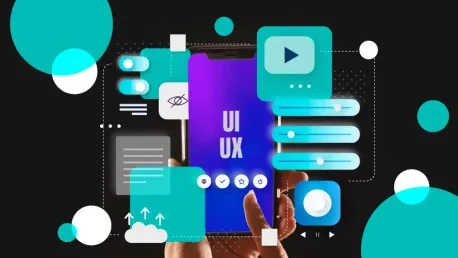In today’s fast-paced, technology-driven environment, the fields of User Interface (UI) and User Experience (UX) design are undergoing a significant transformation. As technology integrates more deeply into every aspect of our lives, UI and UX design are pioneering advancements that transcend traditional websites and mobile applications. The future of UI/UX is shaping up to penetrate every possible industry, from smart cities to healthcare, utilizing innovative tools such as augmented reality (AR), virtual reality (VR), and voice-command technologies. This evolution aims to create intuitive, immersive, and personalized experiences that bridge the physical and digital realms seamlessly.
Emerging Applications for UI/UX Design
Augmented and Virtual Reality
The trajectory of UI/UX design is expanding into novel industries that harness leading-edge technologies. One sector with immense potential is augmented and virtual reality. AR and VR are transforming our interactions with work and entertainment environments. Imagine walking through a virtual store or examining a city’s infrastructure through a smart city application. In these immersive technologies, the role of UI/UX is to guarantee smooth, intuitive interactions that afford users a seamless experience.
AR and VR offer the potential to revolutionize how we handle tasks such as remote collaboration, where virtual meeting spaces can simulate face-to-face interactions, and in the gaming industry, creating more lifelike and engaging experiences. UI/UX design in these fields needs to continually evolve to ensure interfaces are not only aesthetically pleasing but also functional and easy to navigate. Designers must consider elements like spatial awareness and the user’s perspective, enhancing engagement and making experiences feel authentic and interactive.
Smart Cities and IoT
Smart cities are anticipated to become crucial focal points for UI/UX design. With the Internet of Things (IoT) increasingly linking public infrastructure, user-friendly interfaces will be vital in enabling people to interact effortlessly with smart systems, whether managing energy consumption or accessing transportation information in real time. UX design will be instrumental in simplifying these interactions, ensuring that technology integrates smoothly into urban life.
In smart cities, UI/UX design will strive to make complex systems simple for everyday users. This includes developing interfaces for public services that are easily accessible and informative. For example, a smart city dashboard might allow residents to monitor energy usage, track public transportation, or report issues directly to city officials. The integration of IoT devices will require UI/UX designers to prioritize security and privacy, crafting intuitive systems that protect user data while providing valuable insights and services.
Immersive Navigation Experiences
Another domain where UI/UX will wield considerable influence is the evolving field of maps and navigation. As urban landscapes evolve with the integration of smart city technology and AR, the future of UI/UX in maps and navigation will shift toward more immersive and personalized experiences. Navigation tools will transcend simple map displays to offer real-time, contextual data overlays on the physical world. For instance, AR-powered navigation systems could guide users with virtual arrows or prompts visible on smart glasses, making navigation more intuitive without relying solely on handheld devices.
These navigation technologies can significantly enhance daily commutes or explorations in new cities by providing experiential guidance through augmented visual cues. The role of UI/UX in this context will involve creating designs that minimize user distraction and optimize the delivery of real-time information, ensuring that directions are precise and contextually relevant. Additionally, ensuring these interfaces are ergonomically viable, considering accessibility needs, and maintaining clarity in information presentation is crucial for user trust and reliability.
Personalized and Contextual Data
Moreover, maps will dynamically adapt based on user preferences, presenting not only the fastest route but also the most scenic or eco-friendly one, incorporating user data such as past travel patterns or personal interests. Integrating voice commands will enhance hands-free navigation, allowing users to interact seamlessly with maps while driving or walking, ensuring both safety and convenience. This advanced level of personalization and context-awareness in navigation systems will enable users to achieve more tailored experiences that align with their individual preferences and environmental considerations.
The integration of personalized data will also extend to recommending points of interest along the travel route. For example, an individual interested in history might receive notifications about nearby historical landmarks, while a foodie could get prompts about renowned local restaurants. Such tailored guidance encapsulates the potential of UI/UX to transform mundane navigation into enriched, individualized journeys. UI/UX designers will need to ensure that these recommendations are timely and appropriately balanced to prevent information overload and maintain user engagement and satisfaction.
E-commerce and Remote Learning
Enhanced Shopping Experiences
In the realm of e-commerce, shopping experiences will be enhanced through holographic projections and AR, enabling users to virtually try products before purchasing. These innovations necessitate immersive and interactive designs that go beyond the capabilities of traditional screens, pushing the boundaries of UI/UX design. Imagine being able to visualize how a piece of furniture would look in your living room or virtually trying on clothes to see how they fit, all from the comfort of your home.
These enhancements in e-commerce will require UI/UX designers to create fluid, intuitive interfaces that facilitate ease of use and satisfaction. By incorporating smooth transitions, realistic renderings, and responsive feedback, designers can create virtual shopping environments that mimic and perhaps even improve upon in-store experiences. These innovations promise to revolutionize consumer engagement, offering new levels of interactivity and convenience that fundamentally alter how people shop online.
Interactive Educational Tools
The landscape of remote learning and e-learning is poised to evolve, with virtual classrooms and educational tools becoming increasingly interactive. Here, UI/UX design will ensure that students and educators can easily navigate and engage with learning materials in virtual environments, making learning more accessible, interactive, and effective. Virtual classrooms might include holographic teachers, interactive 3D models for subjects like science and history, and immersive environments that provide practical learning experiences.
UI/UX design in education will need to focus on user-friendly interfaces that minimize distractions and foster engagement. For instance, interfaces could enable students to interact with virtual lab equipment or participate in augmented reality field trips. By offering dynamic, interactive learning experiences, UI/UX design can enhance knowledge retention and make remote education more captivating and effective than traditional methods.
Healthcare Innovations
Telemedicine and Patient Care
Furthermore, healthcare and remote medicine will witness UI/UX playing a pivotal role in patient care. As telemedicine expands, intuitive interfaces will help streamline patient-doctor interactions, enabling seamless remote consultations. In hospitals, the design of equipment and patient data systems will significantly improve efficiency and patient outcomes. For telemedicine to be effective, interfaces must be easy to use for both patients and healthcare providers, ensuring clear communication and efficient management of healthcare needs.
As telehealth becomes more prevalent, UI/UX designers will need to create engaging platforms that simplify access to medical services. This could involve designing user-friendly portals for booking appointments, conducting virtual consultations, and accessing medical records. Additionally, interfaces should provide clear and actionable insights derived from the communication, improving the overall healthcare experience and creating a more user-centric approach to medical consultations.
Wearable Health Technologies
The healthcare sector holds significant potential for UI/UX innovation, especially as wearable devices and telemedicine become more widespread. Designers will need to focus on creating user-friendly interfaces for patient monitoring systems and telemedicine platforms to enhance patient outcomes and reduce the cognitive load on healthcare professionals. Wearable technology will require clear, real-time feedback and seamless integration with other devices, making healthcare more accessible and personalized.
Wearable health technologies, such as fitness trackers and smartwatches, are becoming integral tools for monitoring personal health and wellness. UI/UX design in this area needs to prioritize displaying real-time health data in a manner that is both informative and easy to understand. Intuitive interfaces will enable users to track their health metrics, receive timely notifications about potential health concerns, and connect with healthcare professionals for further assistance, ultimately promoting preventive care and a proactive approach to personal health management.
Future Without Physical Devices
Projections and Holographic Displays
Looking ahead, it is plausible that the future may not revolve around physical devices as we currently know them. The advent of projections and holographic displays could supplant traditional screens, allowing users to interact with digital interfaces projected into the air. These projections would be controlled through gesture-based commands or integrated with AR and VR technologies, fundamentally altering how we interact with digital systems. In this context, UI and UX design will be crucial in ensuring smooth, touch-free interactions. Designers will need to focus on crafting intuitive experiences where users can effortlessly engage with digital content in a three-dimensional space.
The transition to a device-free interaction model will pose its own unique set of challenges and opportunities for UI/UX designers. Crafting interfaces that leverage holographic and projection technologies will require rethinking traditional design paradigms, ensuring that interactions are intuitive and free from ergonomic strain. These innovations could revolutionize how we interact with digital content, from working on virtual documents projected in the air to collaborating in holographic conference rooms, thus pushing the boundaries of current UI/UX design disciplines.
Voice Commands and Audio Interactions
Voice commands will play a substantial role in this device-free future. As we transition away from keyboards and touchscreens, voice-activated interfaces will become the primary method for interacting with technology. This shift means that UI/UX design must evolve from a primarily visual focus to one that prioritizes audio and sound-based interactions. The challenge will be to create interfaces that can interpret voice commands accurately and provide clear, engaging feedback through sound. UI/UX designers will need to ensure that these interactions feel natural and intuitive, enhancing user satisfaction.
The adoption of voice commands would entail developing sophisticated natural language processing systems capable of understanding various dialects and speech nuances. Additionally, ensuring that these systems provide comprehensible and contextually appropriate responses is critical. Enabling seamless voice interactions requires attention to user feedback mechanisms where verbal cues are acknowledged promptly, enhancing the overall user experience and ensuring that interactions with digital systems remain fluid and effective.
UI/UX in an Evolving Digital Landscape
In our fast-moving, technology-centric world, User Interface (UI) and User Experience (UX) design are experiencing a profound shift. As technology weaves more tightly into our daily routines, UI and UX design are leading groundbreaking changes that go beyond the conventional boundaries of websites and mobile apps. These advancements are poised to infiltrate virtually every sector, ranging from smart city infrastructure to healthcare systems. Leveraging state-of-the-art tools like augmented reality (AR), virtual reality (VR), and voice-command interfaces, the future of UI/UX design aims to craft experiences that are not only intuitive but also deeply immersive and tailored to individual users. This evolution seeks to create a seamless integration between our physical existence and the digital world, ensuring that users can navigate both realms effortlessly. Furthermore, as these technologies evolve, they promise to make digital interactions more accessible and engaging, ultimately enriching the quality of our lives and enhancing user satisfaction across various platforms and devices.









